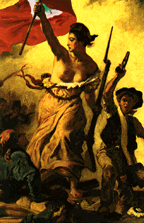 |
TODAY Friday 23 May 1997 Each weekday. Conn Nugent on what's new in the world, on the site. |
newsroom
 |
TODAY Friday 23 May 1997 Each weekday. Conn Nugent on what's new in the world, on the site. |
TODAY IN THE WORLD: Spiffy Cars, Clunker Bikes
There's interesting news on the transportation front, as reported in the New York Times of yesterday and today.
In this morning's edition, Michelle Krebs describes how Ford has joined the club of big automakers who say they are developing a new generation of fuel-efficient vehicles ("Toyota Steps Out" ).This fall Ford will produce and test the first members of the P2000 family, Taurus-like cars designed to get about 80 miles per gallon on the highway. Although different elements of the test vehicles will find their way into mass-produced models in the next few years, the total-package P2000 probably won't be in showrooms before 2004.
Krebs reports that Ford will pursue the same two-track technical strategy long advocated by Amory Lovins. First, cut down the weight of the car and increase its aerodynamic slipperiness. Second, produce energy through a hybrid system whereby a high-efficiency gasoline engine supplies constant power to an electrical drivetrain that turns the wheels. Ford isn't trying to go as far as Amory would like (particularly in what he regards as the key factor of recapturing energy now dissipated through braking), but there's no question that back in 1990 the Sage of Snowmass, Colorado saw more clearly than the rest of us that the low-weight hybrid was the car of the future.
But Amory was also among the first to say that even the most fabulous new car couldn't solve problems intrinsic to dependence on the private automobile as the primary means of going to the places one goes to for satisfying needs and appetites. You still have traffic jams with super-efficient cars and you still have sprawl and the attendant wastes of time, land, materials, and neighborliness. It was important, Amory always said, to talk not about the need for mobility but about the need for access. Not "How can I move around?" but "How can I get the things I want?". All things considered, he said, you might want to grow your own vegetables and walk to the store for a six-pack of beer.
Which brings us to yesterday's Times and its long lead story in the Living section on the revival of the bicycle. After shoeleather, bikes are the great ecological access-providers. And, as it turns out, they've also become merchandising icons for new kinds of residential subdivisions. The focus group people told developers that at least two important upscale demographic sectors were attracted by brochure images of placid bicycle riding: new retirees (looking to live forever) and parents of small children (looking to live in Familyville). Disney's new planned community outside Orlando features a logo of a silhouette of a little girl riding a '50s-era bicycle, her pigtails flying behind in the breeze.
These images reflect an upsurge in recreational biking, impelled by health consciousness, nostalgia, and new bikepaths paid for by the landmark surface transportation bill of 1991. Automobile dependence hasn't really been dented, though, for there are only a very few places in this country (Davis, California is one) where a significant section of the population uses the bicycle as a means to get to work or go shopping. The European experience suggests that for bikes to assume more than 20% of the trips taken by a given population, governments have to make significant infrastructure investments that separate bike lanes from roads. Not likely in America anytime soon: in the debate over the reauthorization of the surface transportation bill, the highway lobby is targeting the miniscule fraction of the total haul that can go to bikepaths and walkways and the like -- sissy stuff that the nation can't afford at a time of fiscal stringency. It'll be tough enough for the enviros just to win back the current modest outlays.
And here, at Liberty Tree World Headquarters, my Innova Giant is parked right in the corner of the office. It hasn't moved for thirteen months. I tried riding in this city, but just couldn't find the intestinal fortitude. It's dangerous out there. So I walk to work, grab the train for longer trips, and for sustenance tend to rely on meals brought to my apartment by intrepid young immigrants -- riding bicycles.
TODAY ON THE SITE
This Website does not underappreciate transportation. Check out these High Five resources:
- Automobiles (Alternative)
- Automobiles (Electric)
- Automobiles (Fuel Economy)
- Automobiles (Sinful)
- Trails (Hike/Bike)
- Trains (High-Speed)
- Transportation
5/22: Petroleum Heresy
5/21: We Irish
5/20: Shallow Backpackers
5/19: Songbirds
5/16: Fat, Fat, Fat
5/15: Our Forthright Administration
5/14: Coral Reefs of the Sahara
5/13: (Life Before) Death and Taxes
5/12: Kids
5/09: Free Trade and Hormones
5/08: Sherry Boehlert, Republican
5/07: Fort Davis, West Texas
5/06: Europe (yawn)
5/05: Divorce, Mothers, Equality
5/02: Killer Grannies and the Highway Bill
5/01: China
4/30: Pity the Mangrove
4/29: Grizzlies off Battery Park
4/28: Mighty Monsanto
4/25: Growth
4/24: Refrigerator Wars
4/23: The Day the Earth Day Stood Still
4/22: Doorman Ecology
4/21: Toyota Steps Out
4/18: Victims of Extremism
4/17: Our White Guy Problem
4/16: Coca-Cola and the Merrit Parkway